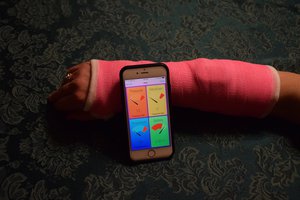Problem Statement & Project Motivation
A meltdown is an intense response to an overwhelming situation. It happens when someone becomes completely overwhelmed by their current situation and temporarily loses control of their behavior. This loss of control can be expressed in many ways.
Meltdowns are not the only way an autistic person may express feeling overwhelmed. They may also refuse to interact, withdrawing from situations they find challenging or avoiding them altogether.
Many autistic people will show signs of distress before having a meltdown. They may start to exhibit signs of anxiety such as pacing, seek reassurance through repetitive questioning or physical signs such as rocking or becoming very still. At this stage, there may still be a chance to prevent a meltdown.
Of the several strategies to consider, this research is based on the proprioceptive properties of a firm hug-like pressure when feeling stressed or overloaded by sensory information. In this situation, some individuals like to be held firmly, but they often dislike physical contact. An alternative is an inflating vest, like that from Squease.
To inflate the vest, specific fine motor skills are required to use the manual pump and get the vest to the correct pressure on time. This would be extremely difficult for certain autistic individuals, particularly with an incoming meltdown or during one.
A working prototype to auto inflate the vest was developed by Tevian. It requires the intervention of the user to select actions from a touch screen. But the inflation itself is done automatically after that. A second, more advanced version of this mechanism, proposed by Tevian, would be the core operating element.
If a sensor, or group of sensors can detect an incoming meltdown, this apparatus could send the necessary commands to the inflating control unit to start the inflation or deflation process without user intervention, possibly providing the proprioceptive effect of a firm hug without physical contact and achieving this before the full onset of the meltdown.
Proposed Solution
Using several biometric sensors in an Edge Machine Learning model, it is proposed that an incoming meltdown can be detected in time to provide the mitigating strategy mentioned above.
Four types of sensors will be explored:
- IMU. Specific or anomalous movement from the individual, either in his body or some body part (i.e., arms, hands).
- Heart Rate. The rate of change, rather than the actual HR, as a signature measure of an increasingly stressful situation.
- EMG. Electrical activity from forearm muscles when making a fist or tensing an otherwise relaxed body.
- Thermal camera. Changes in face temperature as the stressful situation presents itself.
To combine these four sensors, multiple data streams will be created. These will have to be sampled at the same frequency. Then a classification, a regression and/or an anomaly detection model will be applied. Perhaps using different DSP blocks for each data stream.
To execute these experiments, Edge Impulse's platform provides several models that can serve as testing platforms. The learning blocks mentioned above include:
Of all the Edge Impulse tutorials, two could be used for base knowledge into this project:
Additionally, there are a collection of expert and community projects that may provide other insights:
Besides creating own datasets for model training, public datasets will be explored. Preliminarily, these ECG-related datasets from Kaggle will be explored.
While exploring the project data base, I came across a tutorial that uses a commercial EEG sensor (a.k.a. Muse) with ML to detect blinks and also to manipulate several computer elements via concentration tasks....
Read more »





 Alex
Alex


 Danie Conradie
Danie Conradie
Hi!
Did you have a chance to continue on the project?
cheers